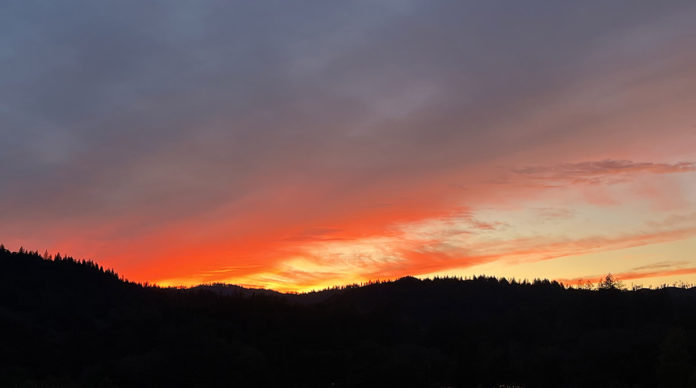Healdsburg could have been called Karlsburg over the last couple of weeks when thick fog settled in the Russian River Valley creating near white-out driving conditions and beautiful sunrises and sunsets.
by Pierre Ratte
“Karl,” actually “Karl the Fog,” is the name given to San Francisco’s legendary mist. The mist that sweeps over coastal mountains, and that one sees driving down Hwy 101 before the Golden Gate Bridge and Robin Williams tunnel. The mist that also finds its way into Sonoma County, bathing our fields with perfect wine-growing conditions, cool nights and warm days.
Karl the Fog’s name stems from German, where Karl was a name given to a “free man,” also a variant of Charles. Karl the Fog’s appearance is quite freewheeling, perhaps the connection to San Francisco’s finicky foggy conditions and name.
Fun facts: The origins of fog generally start with warm air rising from a valley floor. Heavier cold air on surrounding mountain tops slides down slopes and collects on the valley floor. Cold air’s capacity to hold moisture is less than the departing hot air, thus a low-lying mist forms. Even without surrounding mountains, dropping evening temperatures lower the dew point and air near the earth’s moist surface condensing to near 100% relative humidity.
Showy displays of sunrise and sunsets are also a feature of Sonoma’s cloudy days. Particles in the air, either moisture or dust, selectively scatter and filter light, producing orange and reddish hues. This happens as the sun rises and sets because light has to find its way through a thicker atmosphere, causing more light to be scattered in the orange and finally red spectrum.
After Krakatoa’s explosion in 1883, heard 2,000 miles away from a force 13,300 times the atomic bomb dropped on Hiroshima, the sky darkened for years, dropping worldwide temperatures approximately 10 degrees Fahrenheit. Microscopic volcanic particles less than 1/100th the width of human hair, but slightly wider than red wavelengths, absorbed the color red, and many people around the world saw “blue” sunsets and moons. Months and years later, spectacular red sunsets occurred as particle sizes in the atmosphere changed.
Sunset red is a name of a specific color; its hexadecimal code is #E43414, its RGB values are 228, 52, 20, or 76% red, 17% green and 7% blue; Pantone color 485C.








